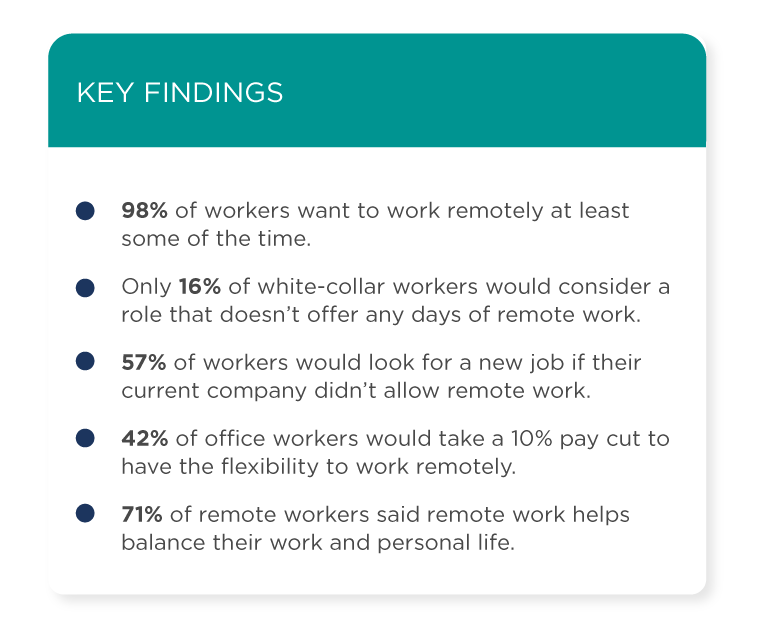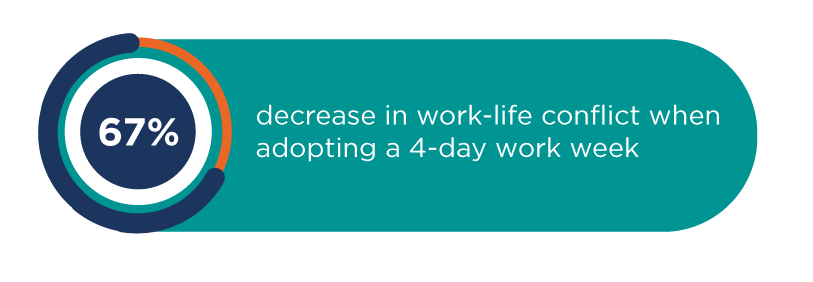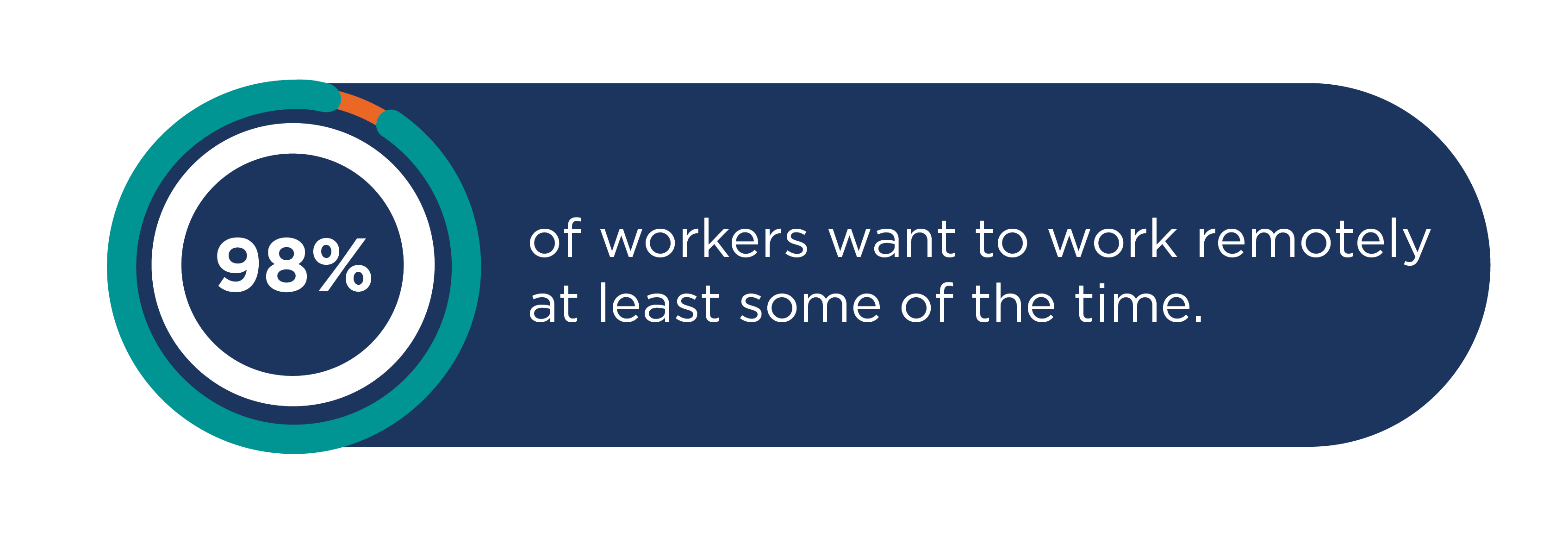April 5, 2024

If there's one thing the pandemic gave us, it's the rise of flexible work arrangements. Remote and hybrid work seemed to pop up overnight and stick around. Furthermore, it's predicted to be a permanent fixture as more and more workers are seeking alternative working arrangements.
But flexible working arrangements can mean a range of different things. How should employers decide what works for them? What is it about a flexible schedule that resonates so deeply with workers in the first place? And how will these arrangements evolve over time?
Here we'll discuss the ins and outs of flexible work arrangements today and how they're predicted to evolve in the future.
Why Flexible Working Arrangements Are So Popular With Employees
At this stage of the game, the benefits of flexible work are typically widely known - at least for the employee. From time and money saved on commuting to improved work/life balance and mental wellness, some benefits of flexible work are clear.
But what may be less clear is just how much employees value these perks. They're so valued that studies have found:
- 98% of workers want to work remotely at least some of the time.
- Only 16% of white-collar workers would consider a role that doesn’t offer any days of remote work.
- 57% of workers would look for a new job if their current company didn’t allow remote work.
- 42% of office workers would take a 10% pay cut to have the flexibility to work remotely.
- 71% of remote workers said remote work helps balance their work and personal life.

Types of Flexible Work Arrangements
Studies have shown that in recent years employee burnout has been at an all-time high, while employee engagement is low, and active disengagement is up. As a response, companies have begun experimenting with an alternative, or flexible, work environment.
Flexible work arrangements refer to alternative work schedules or arrangements to the 40-hour a week in the office. These arrangements allow employees to have more control over when, where, and how they work.
Flexible work arrangements can benefit both employees and employers by promoting better work-life balance, increasing job satisfaction, and even improving productivity. Here are some common types of flexible work arrangements:
Remote Work:
Remote work, also known as telecommuting or working from home, is one you're likely familiar with already. This type of flexible work arrangement allows employees to work outside of the traditional office setting.
Remote workers can work from home, a co-working space, or any location with internet access. Many workers in a remote setting enjoy the freedom to work wherever they choose, the time and money saved from not having to commute, and the increase in work-life balance.
Hybrid Work:
Hybrid work is where employees work partially remotely and partially in the office. The number of days for each ranges depending on the company. Some companies choose to have set in-office days while others allow employees to choose which days they would like to come in.
Hybrid work can provide employees with flexibility in choosing where they work, whether it's from home, a co-working space, or the company's office. This flexibility accommodates diverse preferences, work styles, and personal circumstances.
Flextime:
Flextime, also known as flexible working hours or flexi-time, is a type of work arrangement that allows employees to vary their start and end times within a defined range of hours. Unlike traditional fixed work schedules where employees are expected to work set hours (9 AM to 5 PM), flextime gives employees more control over when they start and finish their workday.
Flextime arrangements will typically have "core hours" where all employees are required to be present at work. For example, a company might set core hours from 10 AM to 3 PM, during which employees must be available for meetings or collaboration.

Compressed Workweek:
A compressed workweek is a type of alternative work schedule that allows employees to work their standard weekly hours in fewer days than the traditional five-day workweek.
Instead of working eight hours a day for five days, employees under a compressed workweek arrangement might work longer hours per day for fewer days per week, four ten-hour days.
A compressed work week can be an appealing option for employees seeking a better work-life balance and can contribute to a positive work culture. It can also lead to increased employee satisfaction when implemented thoughtfully.
Four-Day Workweek
Similar to a compressed workweek, a four-day workweek is simply working four eight-hour days without a decrease in pay.
One of the most notable examples of a company implementing the four-day workweek is the New Zealand-based firm, Perpetual Guardian. They conducted a trial of the four, eight-hour days model in March and April of 2018.
RELATED: The 4-Day Work Week: What Is It and Why It’s Gaining Popularity
The company’s founder, Andrew Barnes, said he wanted to conduct the trial after noticing how much pressure some of his staff were under to manage their personal obligations and professional lives. He thought that giving his employees an extra day to manage their home lives might help relieve some of that stress and contribute to a better focus while in the office.
Turns out, he was right. At the end of the trial, the company reported a 34% drop in absenteeism. A 33% reduction in stress, and a 67% decrease in work-life conflict.

Part-Time Work:
Part-time work involves working fewer hours than the standard full-time position schedule, typically less than 40 hours per week.
While part-time employees may end up taking home a smaller income due to fewer hours worked, this arrangement can be great for people who are looking for more work-life balance.
For many people, part-time work offers a better work-life balance by allowing them to allocate more time to personal pursuits, hobbies, education, or family responsibilities while still earning an income.
Freelancing or Contract Work:
Freelancers or contractors work on a project basis or for a specified period, often remotely and with no set working hours from the employer, allowing the employee flexible schedules dependent on their current projects.

Job Sharing
Job sharing is a work arrangement where two or more part-time employees share the responsibilities and duties of a single full-time position.
This arrangement allows each employee to work part-time hours while collectively covering the workload and responsibilities of the full-time role. Job sharing is often used to provide flexibility to employees and accommodate their various needs and preferences.
Annualized Hours:
Annualized hours refer to a method of scheduling work hours based on a yearly total rather than a weekly or monthly schedule. This approach allows for flexibility in distributing working hours across different periods within the year, depending on business needs and fluctuations in workload.
While annualized hours are not as widespread as traditional fixed-hour schedules or other flexible work arrangements, they are used by a notable number of organizations, particularly in industries with fluctuating workloads or seasonal demands.
Pros and Cons of Flexible Work Arrangements
It may be clear why so many people are drawn to flexible work arrangements, but as with most things, these arrangements can also come with some challenges.
Here we'll discuss some of the most common pros and cons that come with flexible work arrangements.
Pros:
Improved Work-Life Balance:
Research shows that working hours for college graduates have been steadily increasing over the past 30 years. This has left many employees feeling as though they have little to no free time. So, being able to offer employees extra time is always appreciated.
This is one reason why remote and hybrid work is so valued by workers today - time saved on commutes, getting ready in the morning, and meal prepping lunches on the weekends all take up people's personal time. And employees are keenly aware of that.
Flexible work arrangements can allow employees to better balance their professional and personal lives leading to an ideal work-life balance, improved job satisfaction, and even better employee engagement.
Cost Savings:
It may be clear how flexible working arrangements can help employees save money - from gas, child care, and work attire. But in fact, they help employers save as well.
Employers can save on overhead costs associated with maintaining physical office spaces, including rent, utilities, office supplies, equipment maintenance, and janitorial services. With fewer employees in the office at any given time, there may be opportunities to downsize office space or implement shared workspace solutions, further reducing costs.

Improved Mental Health:
Avoiding chaotic mornings, busy commutes, and office politics can have significant impacts on people's mental health - especially for those who may already have a mental health condition.
For instance, a study from Poland found that autistic workers benefited from remote work by limiting or entirely eliminating factors like sensory overload, forced interpersonal interactions, and difficult but expected communications (like small talk).
Flexible work arrangements are often highly valued by employees, leading to increased job satisfaction and even higher retention rates.
Increased Productivity:
Many studies suggest that employees who have flexibility in their work arrangements tend to be more productive due to reduced commuting time, fewer distractions, and a greater sense of autonomy.
Wider Talent Pool:
Employers can attract talent from a broader geographical area when offering flexible work options, leading to a more diverse and skilled workforce.
Remote work options allow employers to access a broader talent pool beyond their local geographic area. This can lead to also cost savings by reducing the need for relocation expenses, offering competitive salaries based on local market rates, and tapping into diverse skill sets and experiences.
Cons:
Communication Challenges:
As effective as Zoom and Teams are for connecting remote workers, it's undeniable that in-person communication will always be the most clear. From body language to tone, to reaction time, speaking to someone face-to-face allows for the purest form of communication.
Remote work can lead to communication issues at times due to the lack of face-to-face interaction. Misunderstandings may arise, due to misunderstandings of tone or intention, making collaboration a bit more challenging.
Social Isolation:
While flexible work arrangements can offer options and inclusivity for people with certain mental health conditions or disabilities, they can also negatively impact the mental health of others.
Remote work, especially if done exclusively, can lead to feelings of isolation and loneliness for some employees. A 2021 study found that working from home exacerbated feelings of depression, anxiety, loneliness, and sleeping difficulties in people who had a history of these symptoms already.
In 2022,another study confirmed these findings by stating that remote workers whose well-being was affected by working from home were more likely to have an existing mental health condition.
One way companies can help minimize this effect is by providing employees with mental health support, either through a corporate wellness program, an EAP that includes mental health resources, and health insurance that covers therapy or counseling.
RELATED: How to Support Your Staff with Employee Mental Health Programs

Potential for Overworking:
Although some leaders still believe that people working remotely don't work as hard, the data shows otherwise. 53% of remote workers say they work more hours out of the office than they do in the office and 63% say they find it more difficult now to "unplug" after hours.
Flexible work arrangements can blur the boundaries between work and personal life, leading to potential issues like overworking, burnout, and difficulty disconnecting from work.
To avoid overworking, leaders will need to pay attention to employees regularly working through lunch or sending emails after hours. And be sure that they themselves have a healthy work/life balance to set expectations.
Remind employees to unplug at the end of the day and don't send emails after hours. Be careful about who you promote as well. If chronic over-workers are the ones who are "getting ahead," think about the message that sends to other employees.

Impact on Company Culture:
A fully remote working arrangement may negatively impact company culture and camaraderie, as face-to-face interactions and team bonding opportunities may be reduced. So much so, Pew research found that 60% of remote employees feel less connected to their coworkers.
Companies can combat this culture disconnect through intentional employee engagement initiatives, but this too will require time, effort, and other resources.
Employee Engagement for Flexible Work Arrangements
An employee recognition program can be a great way to connect employees and boost engagement in any work arrangement. When done correctly, they can be an invaluable tool for businesses.
Terryberry provides solutions to help drive performance and retention through effective employee engagement. These solutions include:
- Wellness Programs: We make it easy to run wellness programs and activity challenges that increase engagement, expand corporate health, and build team camaraderie.
- Pulse Survey Software: Be Heard is an employee engagement survey solution that's designed to enhance your employee experience while fueling business performance.
- Service Awards and Performance Awards: Recognize and reward employees based on years of service awards, anniversaries, or performance.
- Social Recognition: Empower your employees and managers to recognize their peers and celebrate successes with an easy-to-use social recognition application.
Schedule a demo with our team today to see how Terryberry can transform employee engagement at your company.



